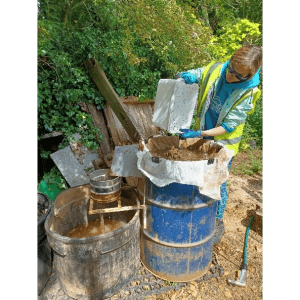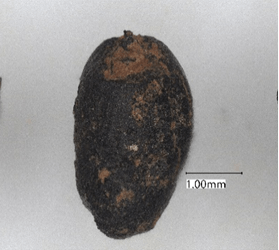Human osteoarchaeology is the study of excavated human skeletons from archaeological sites. Whilst Sofaer (2006) argues that the body is a contested site, torn between biology and material culture, this essay instead proposes that the osteoarchaeological body is a middle ground between these two theologies. The body itself can be regarded as a form of material culture: it exists and “moves” through the material world, which is constructed by both objects and people. Miller defines material objects as a “setting”, they are the backdrop of human life, where agency is played out and social constructs are formed in a physical environment. During the practical, the change from isolated objects, incomplete as separate artefacts, to a whole assemblage impacted my perception on human remains and their materiality.
Osteoarchaeology bridges biology and material culture is through the grave context itself. The boundary of the body is extended to the walls of the grave. In such close proximity objects and body have no choice but to be viewed together, both shaping interpretation of the other. Therefore, not only does the grave restrict what is associated with the body during excavation, the body is constructed by the grave – person and object are intrinsically linked together. However, the issue arise post excavation – bones are often treated as passive objects, in academic literature processes such as disease or epiphyseal fusion are described as happening to the bone, rather than the body being participatory. Furthermore, objects are not passive, they construct and restrict human life – just like a burial context. They should be studied in parallel with each other, not necessarily completely together or completely separate.
Grauer and Miller’s (2017) research on violence, gender and trauma illustrates the intersectionality of material culture and osteoarchaeology. They used the Calendar of Patent Rolls (CPR), a collection of administrative records, alongside skeletal remains to determine the relationship between gender and violence in the medieval period. The CPR also illustrated the perception of violence and its use in the socio-political context of Britain during this period. This enabled a critical analysis of modern ideas concerning medieval violence. For instance; Pitchforks, knives and other dangerous equipment composed the “everyday work-kit”. It is not that these were more likely to cause accidents or that medieval people were inherently more violent – rather the “backdrop” these objects created facilitated violent acts. Subsequently, not only is material culture being used in tandem with osteoarchaeology – CPR was written and catalogued by medieval people, it shaped laws, expectations and most importantly; social norms for medieval Britain. Nevertheless, there are issues with using contemporary ‘objective’ data. If a crime was of no interest to the Crown, there would be no representation of it in this official administrative record.
Whilst osteoarchaeology generates valuable information surroundings past people, it rarely considers culture and personhood. This gap can be supplemented by historical sources – like CPR. Whilst the CPR does not provide a complete picture of violence in medieval England it bridges informational gaps which are not always answerable using osteoarchaeology. For example, the CPR illustrates that women’s tongues and eyes were targets of violence, osteoarchaeologists would be unable to know this as natural tissue decays. This further reinforces the over-arching theme of the essay: in order for osteoarchaeology to obtain in-depth, rich data about past people, the research process must be interweaved with other perspectives and disciplines. Of course, this is not without fault: historical bias of the CPR is unavoidable.
The Western approach towards the “other” (in this case, the dead) is rooted in a specific metaphysical paradigm which is often ignored under the guise of objectivity (Ion, 2016). One such example is the supremacy of scientific knowledge, obtained through osteoarchaeology. In many cases, osteoarchaeology is regarded as respectful and justified – by “giving a voice” to marginalised communities whom are often omitted or absent from the historical record. On the other hand, in some cultures removing the dead from their resting place is an act of structural violence and disrespect. Cases such as these showcase the divide within osteoarchaeology – where biology and the dominating paradigm of science prevents agency being acted out against the backdrop of material culture, negatively impacting marginalised communities.
The ‘contested nature’ of the osteoarchaeological body enables conversations surrounding belonging, meaning, ritual and agency. This is extremely relevant in contemporary debates such as repatriation. Material culture is still at the forefront of this issue; the meaning attributed to Native American bones is different from the perspective of academia. Bones are viewed as a scientific resource, whilst for Native Americans they are their ancestors and family. An anthropology professor from UCLA argued that “(repatriation) implies that you’re giving something back to people who own it. They don’t own it, and never did”. By attaching the verb “own” to the repatriation discussion, it reinforces discourse that human remains are solely an artefact; that repatriation and reburial are at the expense of archaeologists who serve a higher purpose – education and science; knowledge. Bones have fundamental links to rituals – their removal diminishes agency of living descendants, amplifying the colonial and racist roots of osteoarchaeology. Repatriation enables a discourse to be established, through different perspectives and understanding of the body. Archaeological excavation and research has to be justified and collaborative between these communities for the true potential of osteoarchaeology to be achieved. For an archaeologist the past is something to be discovered through excavation and can thereby be analysed and constructed. For Native Americans the past is a part of daily life through spirituality and rituality. Rather than being a middle ground between biology and material culture, osteoarchaeology has the potential to become a meeting point, creating a discipline where the communities involved share the past, rather than archaeologists imposing their own version of it.
Developed from coursework in Post Excavation Analysis unit at the University of Bristol Anthropology and Archaeology Department
Author
Mia Bessette Potts is a current 2nd year studying Archaeology and Anthropology BA. She focuses particularly on how social anthropology and archaeology intersect. She is especially interested in how personhood is constructed for human remains displayed in museums, and re-thinking archaeological methods and practices that viewed as the norm.





